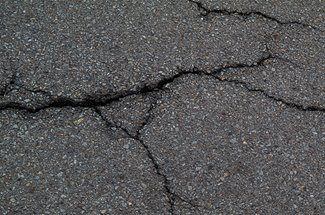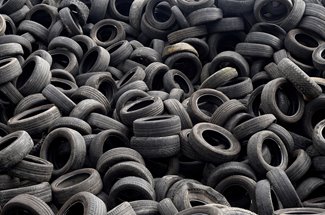5 Ways to Make Roads More Sustainable
5 Ways to Make Roads More Sustainable


New materials and smart systems will be used to link roads with IoT systems and autonomous vehicles.
Date updated: October 30, 2024
Roads haven’t changed much in the last few thousand years. The Romans had the basic idea—a large aggregate covered in smaller stones, topped with something smoother—that we still use today. But the rock used in the base and subbase of today’s roads, as well as the concrete and asphalt used on the surface, has to be mined and hauled to wherever it’s needed. Both are costly and not too environmentally friendly. But now, with more than 4 million miles of road in the U.S. that need constant upkeep, researchers are looking into cheaper, greener, and smarter ways to build streets and highways. Here are five road alternatives and alterations that are most likely to pick up steam—and traffic—as time goes by using sustainability.
The bitumen of asphalt is made up of asphaltenes and maltenes, the latter being the oily resinous material that makes asphalt sticky. It’s also the part that breaks down after oxidation from the relentless abuse of sun and rain. When fissures and potholes grow too large, the traditional treatment has long been to rip up the surface and lay down a new black top. But that extreme solution may soon become a last resort thanks to maltene rejuvenators. These spray-on road elixirs penetrate the road surface and restore the maltenes. Used preventatively, the rejuvenators can extend the life of a road surface by decades.
Some researchers want to get rid of the bitumen altogether. Why? The petroleum product is energy intensive to use, and ultimately not sustainable. The alternative is bio-asphalt, which would use cooking oil, soybean oil, linseed oil, microalgae, and swine manure, among other possibilities. Iowa State University has a bike path paved with bio-asphalt that has been in use since 2010. Sections of road around Belgium’s Langerbrugge Mill have been paved with a bio-asphalt that uses lignin as a binder. Recent research out of Rutgers University, in collaboration with China’s Harbin Institute of Technology, showed bio-asphalts made from corn and castor exhibited “rutting resistance” but didn’t age as well as traditional asphalt. Whether this downside outweighs the green benefits of using bio-asphalts still remains to be seen.
Editor's Pick: Brave New Road
The biggest cost—and environmental detriment—of building a new road comes from aggregate that has to be transported to the site. But companies like PolyPavement can create a road surface with whatever soil might be on site. “If you have a dirt road and want to make it hard like asphalt, without having to import new aggregate, we can add our product to the soil to make it hard, to make it pavement,” said Curtis Reed, the company’s technical consultant. The product is an environment-friendly, water-based polymer, that accentuates the environmental and cost savings of not having to ship rock.
Unlike asphalt, PolyPavement’s product doesn’t break down when exposed to UV light, but actually strengthens. Unlike asphalt, when the surface has been damaged it doesn’t need to be ripped out and replaced. The newly added material adheres to the old for an easy resurfacing. Even if aggregate needs to be imported, the product is cheaper than asphalt, according to the firm.
Every year, the cars we drive or be driven will be fitted with smarter and smarter systems..But there has been much less of a push for roads to be of similar intelligence. Officials of The Ray, an 18-mile section of Interstate 85 in Georgia that is being used to test new road technologies, are trying to remedy that on multiple fronts. That has included using Panasonic’s vehicle-to-everything (V2X) platform to monitor road conditions along that stretch of interstate. This virtual brain allows cars to talk to the road and each other. Not only do these systems help keep vehicles safer, but they can decongest traffic, lower emissions, and warn drivers or their vehicles of maintenance and changing traffic patterns.
Reader's Choice: The Promise of Design Evolution
Globally, more than 1 billion used tires are discarded a year. The U.S. alone contributes some 280 million of those. One way to keep tires out of landfills is to use them to make roads. At the Royal Melbourne Institute of Technology, researchers have mixed old tires with building rubble and shown that it can be used just as effectively in the base layer of roads as more traditional road fill. Adding just half a percent of tire crumb to recycled concrete aggregate can increase the aggregates cohesion.
But where old rubber really shines is on the surface, as part of the asphalt. “When you put ground tire in the road, it lasts longer, you don’t have as much pinning and cracking,” said Laura Rogers, former deputy director of The Ray.
More for You: What is the Future of Supersonic Flights?
The Ray has had a section of asphalt modified with ground tire rubber since 2019. At the University of Auburn’s National Center for Asphalt Technology, trucks have been rumbling over a strip of similar makeup for six years. “It still looks brand new,” Rogers said.
However promising a smart low maintenance road may sound, the biggest obstacle to updating our streets and highways may be inertia within the road construction industry. “There’s no incentive for contractors to build roads that are going to last longer and not need as much maintenance,” said Allie Kelly, The Ray’s executive director. “They like paving a road for the department of transportation and doing it often.”
Michael Abrams is a technology writer based in Westfield, N.J.
Roads haven’t changed much in the last few thousand years. The Romans had the basic idea—a large aggregate covered in smaller stones, topped with something smoother—that we still use today. But the rock used in the base and subbase of today’s roads, as well as the concrete and asphalt used on the surface, has to be mined and hauled to wherever it’s needed. Both are costly and not too environmentally friendly. But now, with more than 4 million miles of road in the U.S. that need constant upkeep, researchers are looking into cheaper, greener, and smarter ways to build streets and highways. Here are five road alternatives and alterations that are most likely to pick up steam—and traffic—as time goes by using sustainability.
1) The Maltene Cure
The bitumen of asphalt is made up of asphaltenes and maltenes, the latter being the oily resinous material that makes asphalt sticky. It’s also the part that breaks down after oxidation from the relentless abuse of sun and rain. When fissures and potholes grow too large, the traditional treatment has long been to rip up the surface and lay down a new black top. But that extreme solution may soon become a last resort thanks to maltene rejuvenators. These spray-on road elixirs penetrate the road surface and restore the maltenes. Used preventatively, the rejuvenators can extend the life of a road surface by decades.
2) Bio Byways
Some researchers want to get rid of the bitumen altogether. Why? The petroleum product is energy intensive to use, and ultimately not sustainable. The alternative is bio-asphalt, which would use cooking oil, soybean oil, linseed oil, microalgae, and swine manure, among other possibilities. Iowa State University has a bike path paved with bio-asphalt that has been in use since 2010. Sections of road around Belgium’s Langerbrugge Mill have been paved with a bio-asphalt that uses lignin as a binder. Recent research out of Rutgers University, in collaboration with China’s Harbin Institute of Technology, showed bio-asphalts made from corn and castor exhibited “rutting resistance” but didn’t age as well as traditional asphalt. Whether this downside outweighs the green benefits of using bio-asphalts still remains to be seen.
Editor's Pick: Brave New Road
3) Taming the Dirt Road
The biggest cost—and environmental detriment—of building a new road comes from aggregate that has to be transported to the site. But companies like PolyPavement can create a road surface with whatever soil might be on site. “If you have a dirt road and want to make it hard like asphalt, without having to import new aggregate, we can add our product to the soil to make it hard, to make it pavement,” said Curtis Reed, the company’s technical consultant. The product is an environment-friendly, water-based polymer, that accentuates the environmental and cost savings of not having to ship rock.
Unlike asphalt, PolyPavement’s product doesn’t break down when exposed to UV light, but actually strengthens. Unlike asphalt, when the surface has been damaged it doesn’t need to be ripped out and replaced. The newly added material adheres to the old for an easy resurfacing. Even if aggregate needs to be imported, the product is cheaper than asphalt, according to the firm.
4) Street Smarts
Every year, the cars we drive or be driven will be fitted with smarter and smarter systems..But there has been much less of a push for roads to be of similar intelligence. Officials of The Ray, an 18-mile section of Interstate 85 in Georgia that is being used to test new road technologies, are trying to remedy that on multiple fronts. That has included using Panasonic’s vehicle-to-everything (V2X) platform to monitor road conditions along that stretch of interstate. This virtual brain allows cars to talk to the road and each other. Not only do these systems help keep vehicles safer, but they can decongest traffic, lower emissions, and warn drivers or their vehicles of maintenance and changing traffic patterns.
Reader's Choice: The Promise of Design Evolution
5) Where the Rubber Meets the Road
Globally, more than 1 billion used tires are discarded a year. The U.S. alone contributes some 280 million of those. One way to keep tires out of landfills is to use them to make roads. At the Royal Melbourne Institute of Technology, researchers have mixed old tires with building rubble and shown that it can be used just as effectively in the base layer of roads as more traditional road fill. Adding just half a percent of tire crumb to recycled concrete aggregate can increase the aggregates cohesion.
But where old rubber really shines is on the surface, as part of the asphalt. “When you put ground tire in the road, it lasts longer, you don’t have as much pinning and cracking,” said Laura Rogers, former deputy director of The Ray.
More for You: What is the Future of Supersonic Flights?
The Ray has had a section of asphalt modified with ground tire rubber since 2019. At the University of Auburn’s National Center for Asphalt Technology, trucks have been rumbling over a strip of similar makeup for six years. “It still looks brand new,” Rogers said.
However promising a smart low maintenance road may sound, the biggest obstacle to updating our streets and highways may be inertia within the road construction industry. “There’s no incentive for contractors to build roads that are going to last longer and not need as much maintenance,” said Allie Kelly, The Ray’s executive director. “They like paving a road for the department of transportation and doing it often.”
Michael Abrams is a technology writer based in Westfield, N.J.








